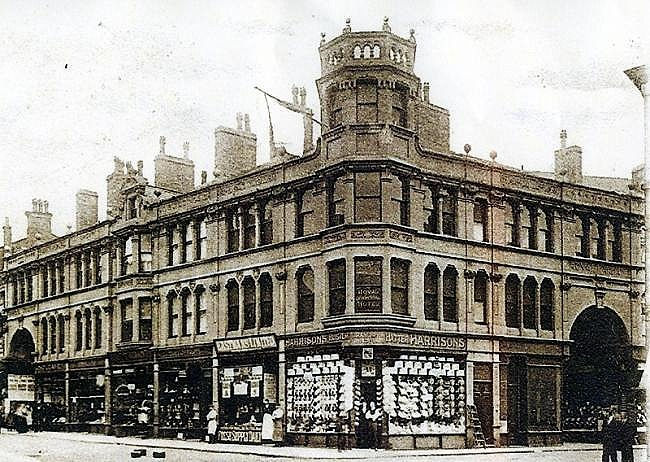
History of The Royal Arcade
1899 - 1987
In March 1899, five months before the last phase of the land purchase was finished, Tuner & Fowlds applied to the local authority for permission to build a covered shopping arcade. While the older buildings on the site would be retained the other buildings would be demolished to make way for the new arcade.
The fundamental element of the plan was to provide the maximum number of shops with shop windows fronting onto publicly accessible roads or walkways. The proposed covered arcade formed a 'T' plan with its entrance on Low Street. The east - west axis of the Turner & Fowlds site ran from Fleece Street to intercept the cross bar of the arcade. To avoid confusion the north - south section of the arcade will now be referred to as the Low Street Arcade and the east - west section as the Fleece Street Arcade.
Within the roughly rectangular plot of land, it was proposed to build 12 shops back-to-back with 6 units having windows into Low Street and 6 with windows onto the Fleece Street Arcade. On both ends of this block there were further units fronting onto Fleece Street and the Low Street Arcade. On the west side of the Low Street Arcade there were to be a further five shops fronting onto the arcade. Two further shops were added at the north end of Fleece Street.
The most distinctive feature of the Royal Arcade was located at the north end of the Low Street Arcade where the covered walkway terminated in a single large, covered area that occupied the yard space of the earlier buildings with a suspended gallery projecting from the north, east and west. The arcade was to be built within a plot of land bounded by Low Street, the proposed Low Street Arcade, Fleece Street Arcade.
As the full depth of the shops at ground level was given over to retail sales, merchandise storage had to be provided elsewhere. For the largest shops, the solution was to provide cellar space accessed by individual flights of steps from the shops above. Below the smaller shops the space was undivided and accessible only from a door and steps in the Low Street Arcade. It is probable that this portion of the cellar was communal and may also have been available to the south range of shops in the Fleece Street Arcade which appear to have been single room lock ups only. Further access to the storage cellar units was by corridors that lay below the arcade walkways.
The application was approved with some minor amendments and complex of shops, arcade and living accommodation above was completed by 1901 and formerly known as the Royal Arcade and Crown Buildings.
Nothing has emerged in documentation to show how successful the Royal Arcade was in returning Turner and Fowlds' investment, but it didn't stay in joint ownership for long. Tuner died in 1915; at that time the Royal Arcade was owned jointly with Hiram Faulds but by 1919 it was in the sole ownership of Tuner's sons Ernest and Wilfrid. As soon as they had taken control of the site, the Turner brothers began a piecemeal disposal of the property. By 1933 a large proportion of the arcade was owned by Frank Butterfield.
Butterfield had been a partner in Gott & Butterfield's iron mongers who had been tenants at the arcade since at least 1919. Their shop was once described as an 'Aladdin's cave' selling household goods, bicycles and camping equipment and the whole arcade was popularly known as 'Butterfield's Arcade'.
Frank Butterfield Ltd. continued to run the arcade but by the 1980s the business was in decline and the arcade was in very poor condition and it finally closed in 1987.
History of The Royal Arcade
1999 - Present Day
In 1999 it was acquired by Kingfisher Developments and proposed to renovate the Grade 2 listed building to its former Edwardian splendour.
During the early stages of this renovation a clearance programme was undertaken including the cellars which by that time were almost completely full of rubbish. It was at that time that the true nature of the cellars was discovered for the first time.
Once the cellars had been partially cleared it became apparent that there was a complete lower-level arcade of shops below the ground along both sides of an underground 'street'. Some of the shops still have their glass windows intact, together with front doors, letterboxes and door numbers.
A number of enamel advertising signs were found indicating that the shops were probably used from an early date, perhaps even from the opening of the Royal Arcade and Crown Buildings in 1901.
The accessible shops and cellars run around three sides of the plot of land bounded by Low Street, Fleece Street and the Royal Arcade. The original pedestrian entrances to the arcade was down stone steps in Hangover Street and to the rear of Fleece Street but these stairs have now been sealed and the only access to the underground area is down a flight of wooden steps at the rear of the site, this was originally the end of a short cart track used for deliveries to the shops.
Originally most of the cellars had wooden stairs up to the shops above; most of these have now gone although there is still access from one or two of the shops. The arcade was lit by 'pavement lights' set into the pedestrian walkways and streets but these have all now been covered over and the cellars are in darkness.
Once the restoration of the arcade had been completed it was officially reopened as by Keighley historian Ian Dewhirst on the 27th of June 2003. The Royal Arcade now consists of 14 shops on the ground floor and 23 flats on the upper floors.








